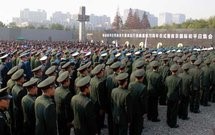 China’s National People’s Congress in March 2014 announced that it would increase its defence budget to 808.23 billion yuan (132 billion dollars). In 2013, it was 720.2 billion (117 billion dollars) yuan amounting to an increase of 12. 2 per cent. China does not release any more than the breakdown of expenditure at broad categories, complicating investigation about the priorities.
China’s National People’s Congress in March 2014 announced that it would increase its defence budget to 808.23 billion yuan (132 billion dollars). In 2013, it was 720.2 billion (117 billion dollars) yuan amounting to an increase of 12. 2 per cent. China does not release any more than the breakdown of expenditure at broad categories, complicating investigation about the priorities.
However, it is possible to assess broadly its defence expenditure through statements from officials, news reports and white papers. The 2014 budget does not show any drastic increase and low compared to the GDP ratio. It however emphasises China’s shift to structural reforms for the military, in particular utilisation of defence spending towards boosting investment in training, weaponry and equipment.
China’s defence budget roughly covers personnel expenses renyuan shenghuo fei (military officers, civilian cadres, soldiers and employers wages, insurance, food and clothing); secondly, training and maintenance xunlian weite fei (troops training, college education, engineering facilities construction and maintenance, and everyday expenses); third, equipment expenses zhuangbei fei (weaponry and equipment research, testing, procurement, maintenance, transportation and storage).
From 2013, China started emphasising on structural reforms and reorganisation for the military. The 2014 budget therefore stresses the shift towards training and investment in new high-technology weapons and equipment by encouraging more private enterprises to enter military procurement. In Chinese view, it would reduce reliance on foreign imports and boost defence industry and in turn, economic growth. The PLA Navy, Air Force, Army Aviation, Aerospace, and the PLA Second Artillery would receive more attention.
Xi Jinping vision for the PLA, the dictum of ‘fight war, win war’ (neng dazhang, da shengzhang), would provide the theoretical structure for China’s military construction. The General Staff Headquarters had identified Xi’s vision for as the fundamental goal that would drive military construction.1 This budget adheres to this policy, which underlines capability to win a war. The military would “develop new type of weapon equipment and strengthen military exercises” and “improve army informationalisation under deterrence and combat conditions”. Apart from equipment, the PLA Navy would receive more expenses for conducting exercises in the high seas.
Since the Xi vision stresses on “capability to win”, the military spending is shifting towards higher technology weapons and equipment and training. This coincides with the Chinese Commission of Science, Technology and Industry for National Defense plan that was passed in 2006 for facilitating high-technology research. The plan proposed to “enhance the capability to innovate, develop and rapidly supply new-generation weaponry” and new and high-tech weaponry and industries, manufacturing, basic and frontier technologies. Thus, China would have to utilise local governments to play a role in the military expenditure and allow “market” mechanism to operate in the military spending and encourage civil-military integration.
For instance, there is a concerted effort to localise army construction and incentivise the use of local resources. Chen Xiangdong, the political commissar of General Staff, Army Aviation Department proposed constructing new airports by resolving difficulties in expropriation and redefine local government’s role in the protection of military installations. His proposals call for the military to integrate in the local government economic construction.
Li Danni, the Director of Naval Submarine School, recommended to improve the training of Noncommissioned Officers (NCO) because integrated training resources would help as the local enterprises and research institutes rely on NCO for maintaining high-tech weaponry. The focus of defence expenditure is also on developing high-technology defence in military and non-military enterprises that would equip their private industries to meet PLA’s increasing demand on weaponry and equipment. Future demands would focus on naval vessels, combat aircraft including transport aircraft, helicopters, aircraft engines, gas turbines, and defence information equipment.
The expenditure would also cover personnel reforms, especially living and working conditions of forces in the remote and frontier areas. Broadly, it would attempt to improve modernisation level of weapons and equipment, benefits to personnel (living and working conditions), and troops organisation reform. Such measures may mean the Chinese military is geared up for reduction in personnel size (noncombatants), and improve joint operational and theatre command structures and training.
Sun Huangtian, Vice-Minister of General Logistics Department explains about China’s broad focus: stop the upgradation of outdated equipment and intensify the upgradation of backward equipment; welfare benefits and education training, improvement in living, training and working conditions, and other official funds for office projects for military personnel; reform military management, civil-military integration, troops organisation (joint operations) and political system.
After the release of figures, China deflected criticism using three arguments: one, it is in line with its economic growth and is still well below the US military spending, especially compared to the GDP ratio; second, it is necessary given the increasingly complex security environment in China’s periphery; third, it needs to develop military capabilities through investment in high-tech weapon technology research. It reflects that China perceives an evolution of a complex security environment, which is seemingly against it, in turn, reveals certain level of insecurity.
Chinese defence spending exposes its intention to streamline its military modernisation to make it sustainable and build a defence industry that could provide for its procurement needs. It also illustrates its aim to institute reforms related to troop’s operational commands, organisation and training. Though it is low in GDP ratio, the Chinese view that its defence spending is integral for its core interest would see the PLA more actively engaging in managing disputes. On the other hand, it begs the question whether China could successfully employ its military expenditure to provide for the PLA’s “fight war, win war” strategy.
By Special Arrangement with The Institute for Defence Studies and Analyses (www.idsa.in)